System And Apparatus For Reactions
Grover; Simon Roderick ; et al.
U.S. patent application number 16/057209 was filed with the patent office on 2019-02-07 for system and apparatus for reactions. The applicant listed for this patent is ALERE SWITZERLAND GMBH. Invention is credited to Wai Ting Chan, Martyn Gray Darnbrough Beedham, Olivier Fernand Flick, Simon Roderick Grover, Richard John Hammond, Henry Charles Innes, Nicholas David Long, Peter Laurence Mayne, Nick David Rollings, Natalie Frances Scott, Paul Graham Wilkins.
| Application Number | 20190039059 16/057209 |
| Document ID | / |
| Family ID | 46889055 |
| Filed Date | 2019-02-07 |
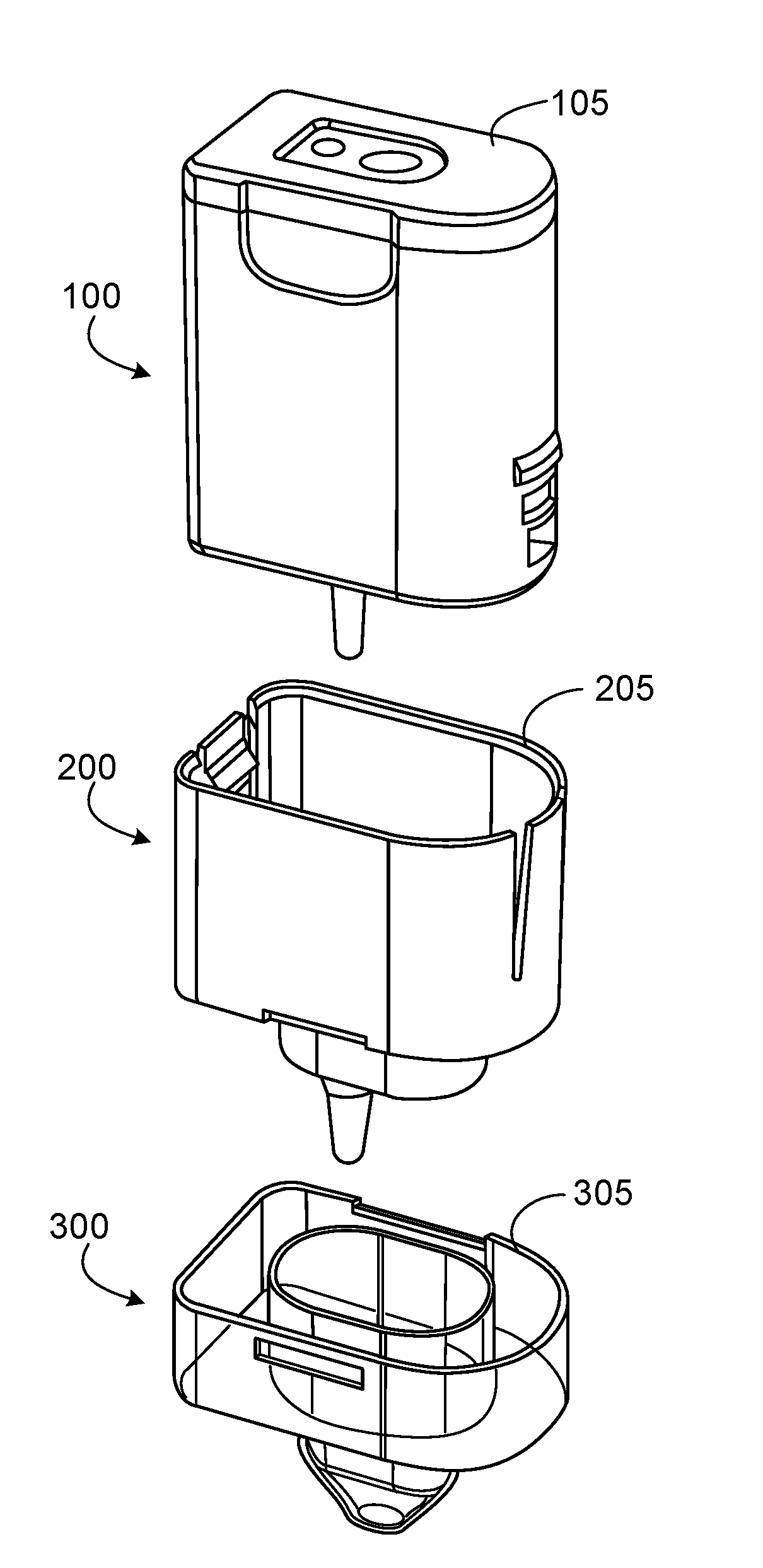



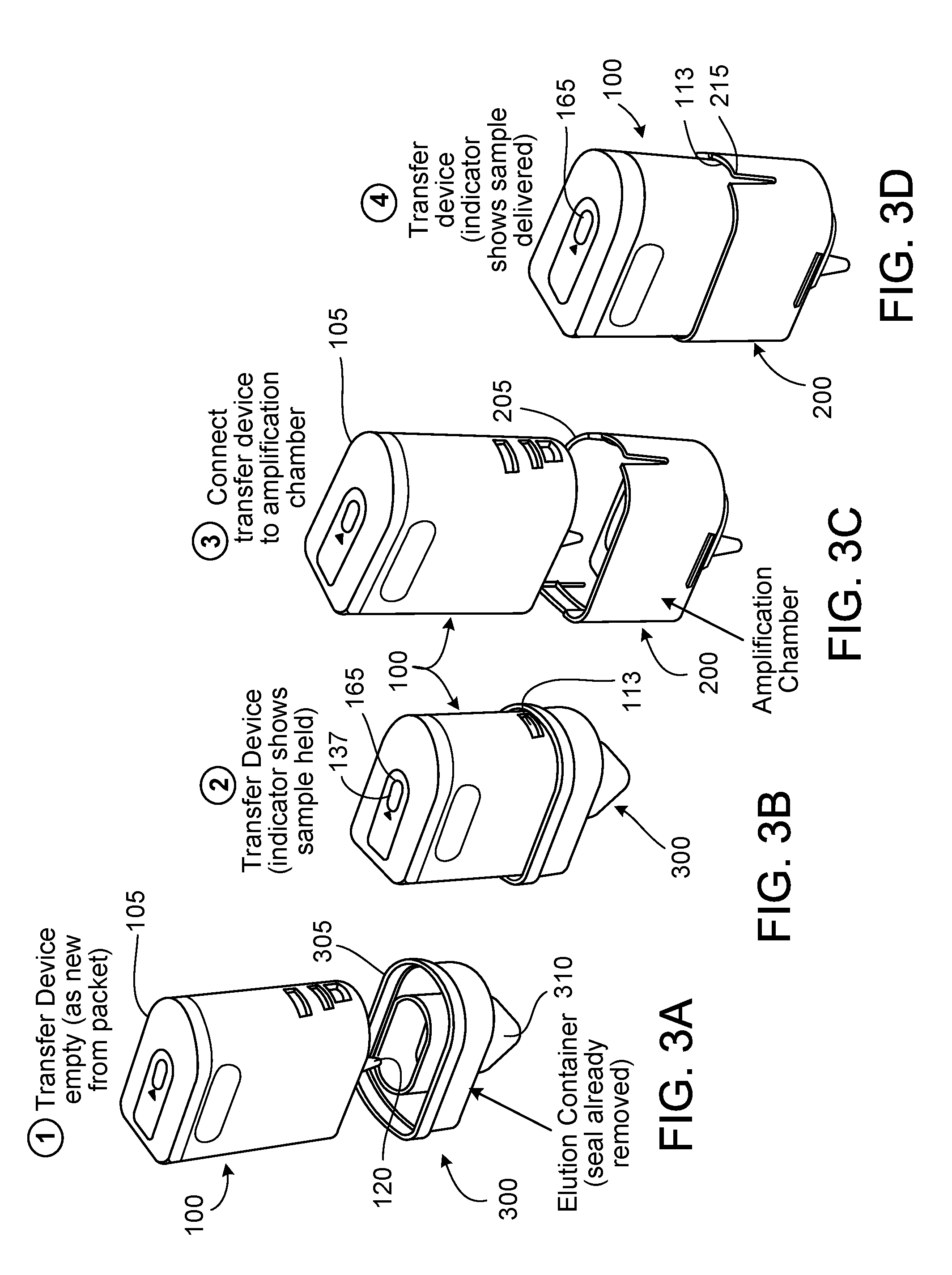

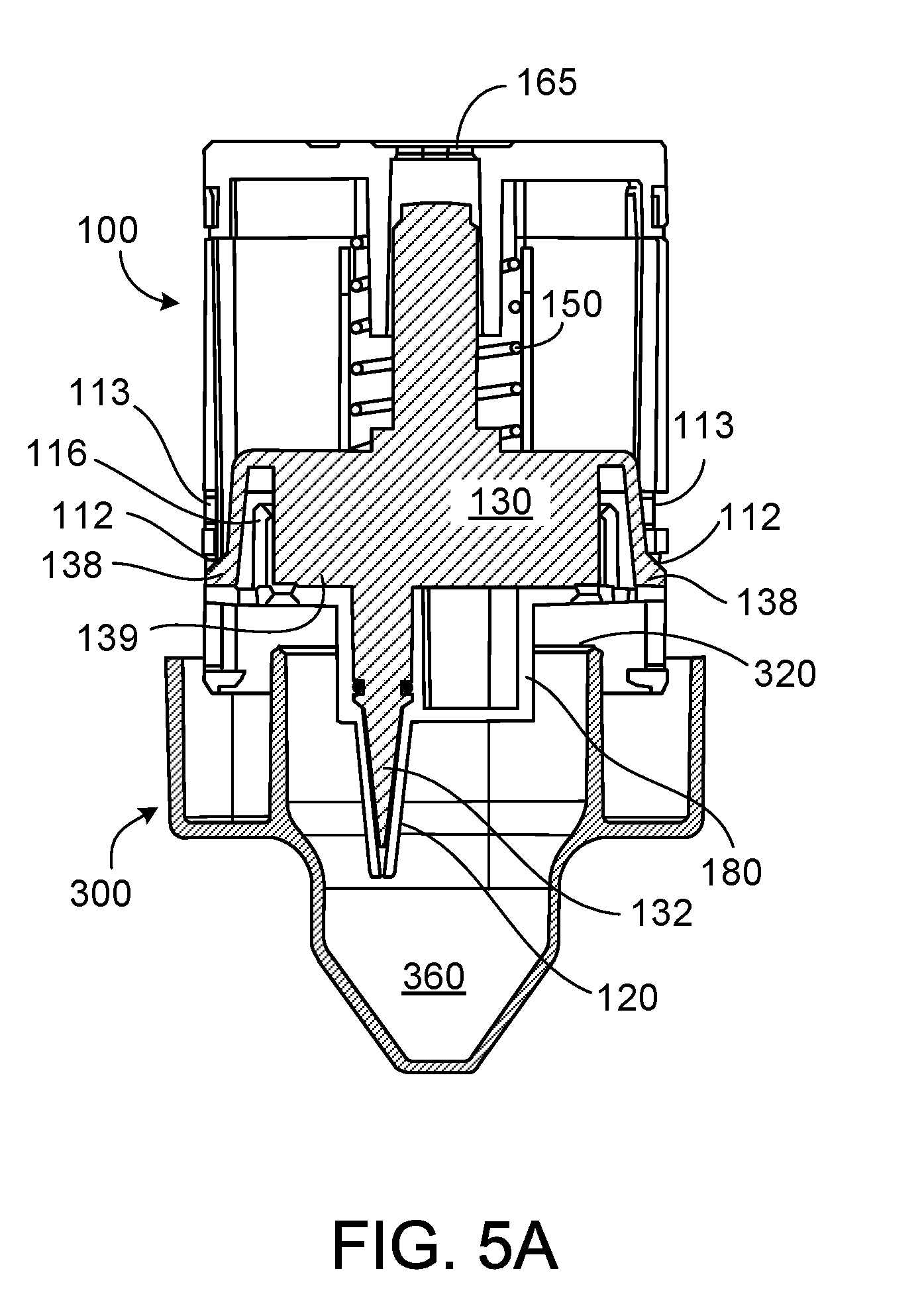

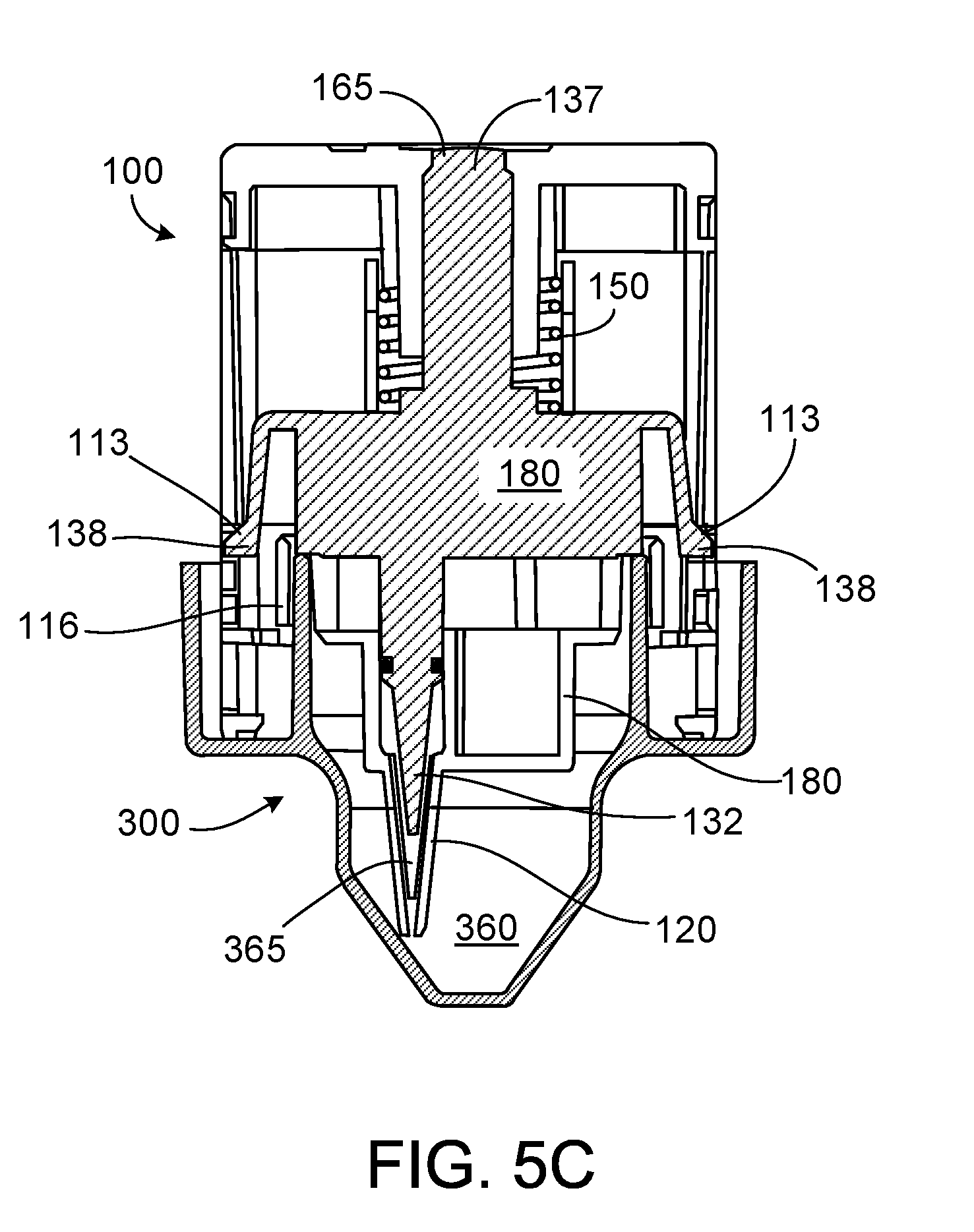
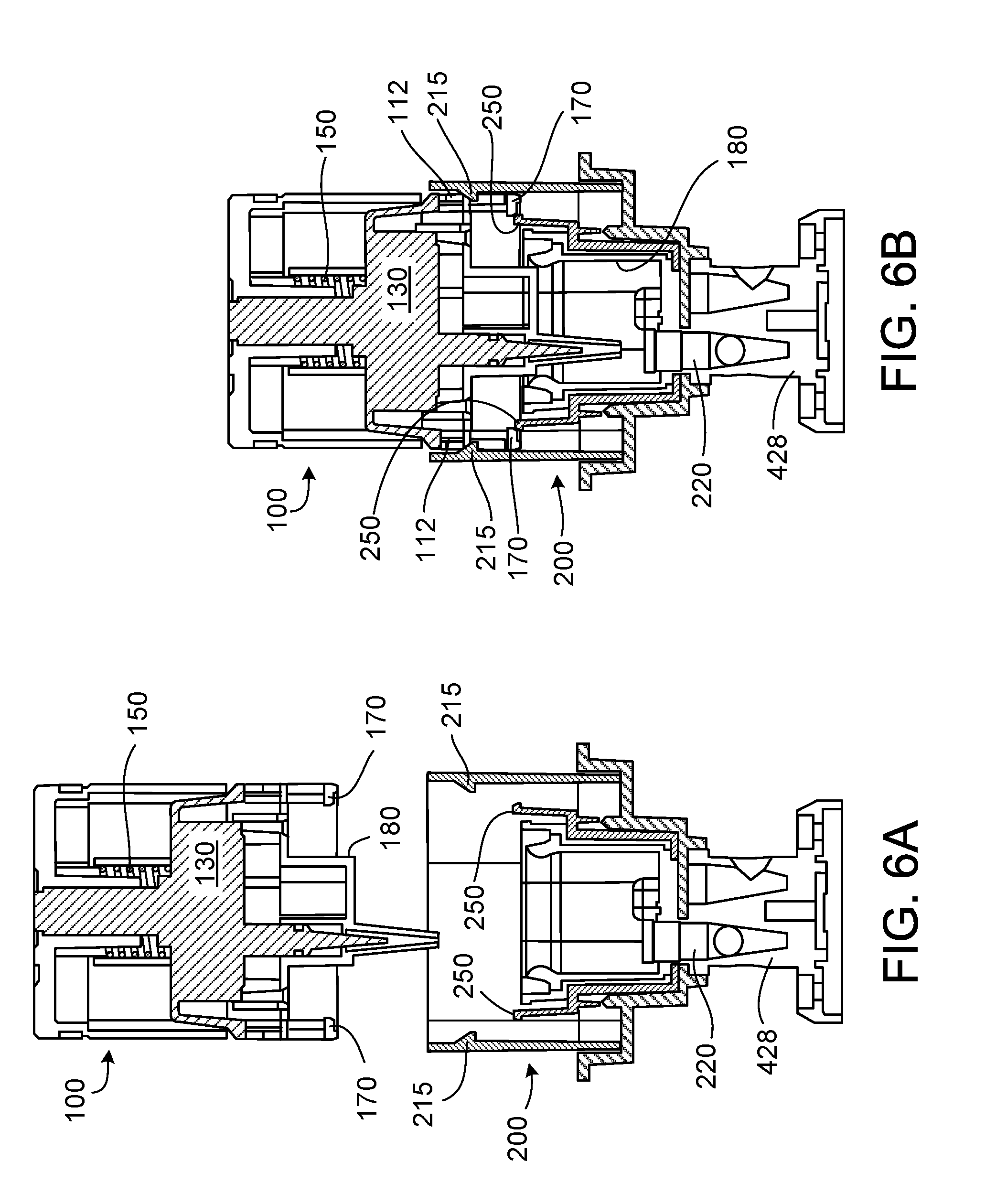

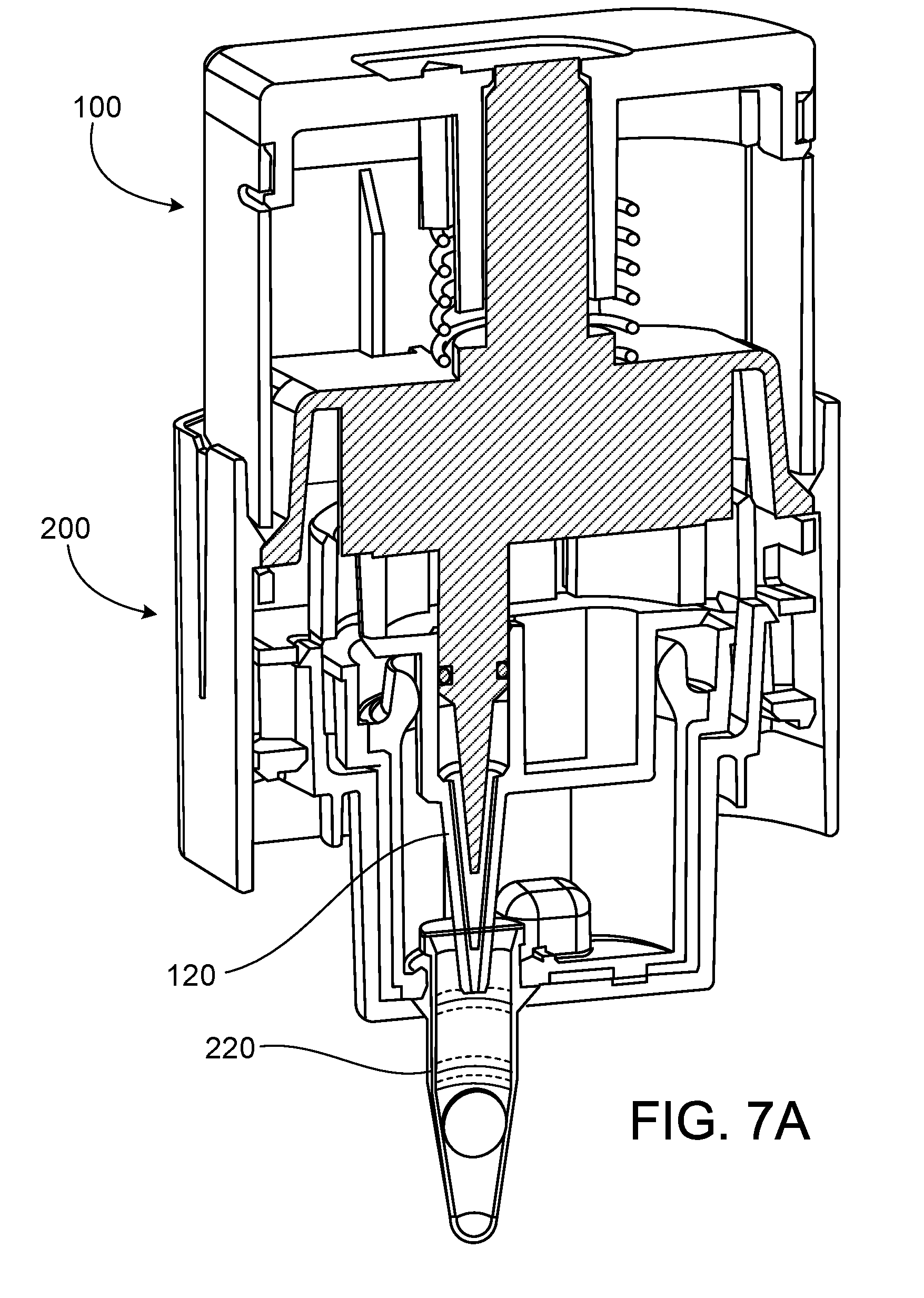
View All Diagrams
| United States Patent Application | 20190039059 |
| Kind Code | A1 |
| Grover; Simon Roderick ; et al. | February 7, 2019 |
SYSTEM AND APPARATUS FOR REACTIONS
Abstract
This disclosure provides systems, apparatuses, and methods for liquid transfer and performing reactions. In one aspect, a system includes a liquid transfer device having a housing having a pipette tip and a plunger assembly; and a reaction chamber, wherein the housing of the liquid transfer device is configured to sealably engage with the reaction chamber. In another aspect, a liquid transfer device including a housing having a pipette tip; and a plunger assembly disposed within the housing and the pipette tip, wherein a portion of the plunger assembly is configured to engage a fluid reservoir such that the plunger assembly remains stationary relative to the fluid reservoir and the housing moves relative to the plunger assembly.
| Inventors: | Grover; Simon Roderick; (Cambridge, GB) ; Wilkins; Paul Graham; (Cambridge, GB) ; Rollings; Nick David; (St. Albans, GB) ; Mayne; Peter Laurence; (London, GB) ; Chan; Wai Ting; (Cambridge, GB) ; Scott; Natalie Frances; (Cambridge, GB) ; Flick; Olivier Fernand; (Cambridge, GB) ; Innes; Henry Charles; (Princeton, NJ) ; Darnbrough Beedham; Martyn Gray; (Cambridge, GB) ; Long; Nicholas David; (Harrold, GB) ; Hammond; Richard John; (Foxton, GB) | ||||||||||
| Applicant: |
|
||||||||||
|---|---|---|---|---|---|---|---|---|---|---|---|
| Family ID: | 46889055 | ||||||||||
| Appl. No.: | 16/057209 | ||||||||||
| Filed: | August 7, 2018 |
Related U.S. Patent Documents
| Application Number | Filing Date | Patent Number | ||
|---|---|---|---|---|
| 15141190 | Apr 28, 2016 | 10040061 | ||
| 16057209 | ||||
| 13242999 | Sep 23, 2011 | 9352312 | ||
| 15141190 | ||||
| Current U.S. Class: | 1/1 |
| Current CPC Class: | B01L 3/0217 20130101; B01L 2200/16 20130101; B01L 2400/0478 20130101; B01L 2300/025 20130101; Y10T 436/2575 20150115; B01L 3/502 20130101; B01L 2200/026 20130101; A61J 1/2096 20130101; B01L 2200/025 20130101 |
| International Class: | B01L 3/02 20060101 B01L003/02; B01L 3/00 20060101 B01L003/00 |
Claims
1-17. (canceled)
18. A method comprising: (i) obtaining a liquid sample from a sample reservoir using a liquid transfer device comprising: a housing comprising a pipette tip; and a plunger unit disposed within the housing, wherein a portion of the plunger unit is configured to engage a fluid reservoir such that the plunger unit remains stationary relative to the fluid reservoir and the housing moves relative to the plunger unit to draw a fluid from the fluid reservoir through the pipette tip; and (ii) dispensing the liquid sample.
19. The method of claim 18, wherein dispensing the liquid sample comprises dispensing the liquid sample into a reaction chamber comprising one or more components of a reaction.
20. A method comprising: (i) obtaining a liquid sample from a fluid reservoir using a liquid transfer device; and (ii) dispensing the liquid sample into a reaction chamber, wherein the liquid transfer device sealably engages with the reaction chamber during or prior to dispensing.
21. A method comprising: (i) obtaining a liquid sample from a fluid reservoir using a liquid transfer device; and (ii) dispensing the liquid sample into a reaction chamber, wherein the liquid transfer device lockably engages with the reaction chamber during or prior to dispensing.
22. The method of claim 21, further comprising: (iii) interfacing the reaction chamber and the fluid reservoir, such that the reaction chamber lockably engages with the fluid reservoir.
23-25. (canceled)
26. The method of claim 18, the plunger unit including a syringe plunger that seals within the pipette tip with an o-ring.
27. The method of claim 18, wherein movement of the housing relative to the plunger unit results in creation of a vacuum within the pipette tip.
28. The method of claim 18, wherein the housing is configured to move relative to the plunger unit when the housing is advanced toward the fluid reservoir.
29. The method of claim 27, wherein the plunger unit is configured to lock in a position resulting in creation of the vacuum.
30. The method of claim 27, wherein the device is configured to provide at least one of an auditory and visual indication that the plunger unit is in a position resulting in the creation of the vacuum.
31. The method of claim 18, wherein the plunger unit is configured to reversibly lock in a position that causes fluid from the fluid reservoir to flow into the pipette tip.
Description
CROSS-REFERENCE TO RELATED APPLICATION
[0001] This application is a divisional of U.S. patent application Ser. No. 15/141,190, filed Apr. 28, 2016, which is a continuation and claims priority to U.S. patent application Ser. No. 13/242,999, filed Sep. 23, 2011, now U.S. Pat. No. 9,352,312, Issued May 31, 2016, the entire contents of which are incorporated by reference.
TECHNICAL FIELD
[0002] This invention relates to systems and apparatuses for liquid transfer and carrying out reactions.
BACKGROUND
[0003] Many diagnostic tests that involve biological reactions are required to be performed in laboratories by skilled technicians and/or complex equipment. Such laboratories may be the subject of government regulation. The costs of compliance with such regulations can increase the costs of diagnostic tests to patients and health care payers and exclude such tests from point-of-care facilities. There is a need for systems for performing diagnostic tests involving biological reactions that can be used without extensive training at the point of care.
SUMMARY
[0004] The present disclosure provides systems, apparatuses and methods for transfer of liquids and processing of reactions, e.g., in diagnostic tests.
[0005] In one aspect, the disclosure features a system that includes a liquid transfer device that includes a housing having a pipette tip and a plunger assembly; and a reaction chamber, wherein the housing of the liquid transfer device is configured to sealably engage with the reaction chamber. In some embodiments, the housing of the liquid transfer device can include a seal component configured to sealably engage with the reaction chamber. In some embodiments, the reaction chamber can include a seal component configured to sealably engage with the liquid transfer device. The systems can further include a fluid reservoir, and the reaction chamber can optionally be configured to lockably engage with the fluid reservoir.
[0006] The liquid transfer device can be configured to lockably engage with the reaction chamber, e.g., without dispensing, prior to dispensing, and/or after dispensing a liquid sample.
[0007] In some embodiments, the reaction chamber includes one or more components of a biological reaction.
[0008] In another aspect, the disclosure features a liquid transfer device that includes a housing having a pipette tip; and a plunger assembly disposed within the housing and the pipette tip, wherein a portion of the plunger assembly is configured to engage a fluid reservoir such that the plunger assembly remains stationary relative to the fluid reservoir and the housing moves relative to the plunger assembly.
[0009] In some embodiments, movement of the housing relative to the plunger assembly results in creation of a vacuum within the pipette tip and, optionally, the plunger assembly can be configured to lock in a position resulting in creation of the vacuum. The housing can be configured to move relative to the plunger assembly by pushing the housing down on the fluid reservoir. The device can further be configured to provide an auditory and/or visual indication that the plunger assembly is in a position resulting in the creation of the vacuum.
[0010] A system can include the liquid transfer device and one or more of a fluid reservoir and reaction chamber. When a reaction chamber is included, the reaction chamber can be configured to unlock the plunger assembly when the liquid transfer device and the reaction chamber are interfaced.
[0011] In another aspect, the disclosure features a liquid transfer device configured to draw a sample from a fluid reservoir by pushing the device against the reservoir and systems that include the liquid transfer device and one or both of a reaction chamber and fluid reservoir.
[0012] In the systems described above, two or all three of the liquid transfer device, reaction chamber, and fluid reservoir can have compatible asymmetric cross-sections.
[0013] In another aspect, the disclosure features methods that include (i) obtaining a liquid sample from a sample reservoir using a liquid transfer device described above; and (ii) dispensing the liquid sample, e.g., into a reaction chamber comprising one or more components of a reaction.
[0014] In another aspect, the disclosure features methods that include (i) obtaining a liquid sample from a fluid reservoir using a liquid transfer device (e.g., a liquid transfer device described above); and (ii) dispensing the liquid sample into a reaction chamber, wherein the liquid transfer device sealably engages with the reaction chamber during or prior to dispensing.
[0015] In another aspect, the disclosure features methods that include (i) obtaining a liquid sample from a fluid reservoir using a liquid transfer device (e.g., a liquid transfer device described above); and (ii) dispensing the liquid sample into a reaction chamber, wherein the liquid transfer device lockably engages with the reaction chamber during or prior to dispensing. The methods can further include (iii) interfacing the reaction chamber and the fluid reservoir, such that the reaction chamber lockably engages with the fluid reservoir.
[0016] The systems, apparatuses, and methods disclosed herein can provide for simple analysis of unprocessed biological specimens. They can be used with minimal scientific and technical knowledge, and any knowledge required may be obtained through simple instruction. They can be used with minimal and limited experience. The systems and apparatuses allow for prepackaging or premeasuring of reagents, such that no special handling, precautions, or storage conditions are required. The operational steps can be either automatically executed or easily controlled, e.g., through the use of auditory and/or visual indicators of operation of the systems and apparatuses.
[0017] The details of one or more embodiments of the invention are set forth in the accompanying drawings and the description below. Other features, objects, and advantages of the invention will be apparent from the description and drawings, and from the claims.
DESCRIPTION OF DRAWINGS
[0018] FIG. 1 is an exploded view of an exemplary system as described herein.
[0019] FIGS. 2A-2C are exploded views of system subassemblies.
[0020] FIG. 2D is a view of the system mated and joined.
[0021] FIGS. 3A-3D depict the system in use.
[0022] FIG. 4 depicts the system in the context of an exemplary detection device.
[0023] FIGS. 5A-5C depict the system in cross-section during sample collection.
[0024] FIGS. 6A-6D depict the system in cross-section during sample dispensing.
[0025] FIGS. 7A-7B depict single (7A) and double (7B) variants of the system.
DETAILED DESCRIPTION
[0026] This application describes systems, apparatuses, and methods for transfer of liquids and processing of biological reactions (e.g., nucleic acid amplification reactions).
[0027] Referring to FIG. 1, the system can include three subassemblies: a transfer device 100, amplification chamber 200, and an elution container 300. Each subassembly can have a D-shaped or otherwise asymmetrical cross section 105, 205, 305 that is compatible with the other two subassemblies, such that the subassemblies may only be mated to each other in one orientation.
[0028] FIGS. 2A-2C, show exploded views of the subassemblies 100, 200, and 300, respectively. In FIG. 2A, the transfer device 100 includes a body 110 having a D-shaped or otherwise asymmetrical cross section 105 and a pipette tip 120. The transfer device also includes a plunger unit 130 having a syringe plunger 135 that seals within the pipette tip 120 using an o-ring 140. The plunger unit also includes flexible arms 131 having tabs 138 that are aligned with two sets of lower 112 and upper 113 slots in the body 110. Ridges within the body 110 align with grooves in the plunger unit 130 to guide the plunger unit 130 up and down within the body 110. When the plunger unit 130 is in the lower position, the tabs 138 insert into the lower slots 112. When the plunger unit 130 is in the upper position, the tabs 138 insert into the upper slots 113. A spring 150 fits over a spring guide 139 of the plunger unit 130, and can be compressed against the cap 160 when the transfer device 100 is assembled. When the plunger unit 130 is in the upper position, an indicator 137 at the top of the spring guide 139 is visible through an indicator window 165 in the cap 160.
[0029] In FIG. 2B, the amplification chamber 200 includes a body 210 having a D-shaped or otherwise asymmetrical cross-section 205 that is compatible with the cross-section 105 of the transfer device 100. The amplification chamber body 210 also includes two tabs 215 that insert into either the lower slots 112 or upper slots 113 of the transfer device 100 when the two subassemblies are mated. The reaction chamber 200 also includes a microtube 220 having a retaining ring 225 that holds the microtube 220 within an aperture in the bottom of the amplification chamber body 210. The microtube 220 can also have a seal 228 that covers the mouth 223 of the tube 220. In some embodiments, the microtube 220 is optically permeable to allow monitoring of its contents. The amplification chamber 200 also includes a sealing component 230 that fits within the amplification chamber body 210 and over the microtube 220, holding it in place. The sealing component 230 includes a pliant gasket 235 configured to seal against the pipette housing 180 when the two subassemblies are mated (see FIGS. 6A-6D). Two side tabs 240 are present near the bottom of the body 210 of the amplification chamber 200.
[0030] In FIG. 2C, the elution container 300 has a D-shaped or otherwise asymmetrical cross-section 305 that is compatible with the cross-section 105 of the transfer device 100. The elution container 300 includes an elution buffer reservoir 310 and a guide ring 320 compatible with a pipette housing 180 of the transfer device 100. A seal can cover the mouth of the buffer reservoir 310 or guide ring 320. Two notches 340 are present on the side walls 350 of the elution chamber 300, into which insert the side tabs 240 of the amplification chamber 200 when the two subassemblies are mated.
[0031] FIG. 2D shows the three subassemblies of the system mated and joined for disposal. The transfer device 100 locks into the amplification chamber 200 by insertion of the amplification chamber tabs 215 into the upper slots 113 of the transfer device 100. Similarly, the amplification chamber 200 locks into the elution chamber 300 by insertion of the side tabs 240 of the amplification chamber 200 into the notches 340 of the elution chamber 300. In this configuration, the patient sample and any amplified nucleic acids are sealed within the system to prevent contamination. Approximate dimensions of the joined system are shown.
[0032] FIGS. 3A-3D show an overview of the system in operation. In FIG. 3A, the transfer device 100 is positioned above the elution chamber 300 with their D-shaped cross-sections 105 and 305 aligned. In FIG. 3B, the transfer device 100 is pushed down on the elution chamber 300, such that the pipette tip 120 enters the buffer reservoir 310 and the plunger unit 130 remains stationary relative to the body 110 due to contact with a guide ring on the buffer reservoir 310. This results in the plunger unit 130 in the upper position, compressing the spring 150 such that the indicator 137 shows through the indicator window 165. The presence of the indicator 137 in the indicator window 165 and an audible click as the tabs 138 insert into the upper slots 113 provide auditory and visual feedback that the transfer device has been manipulated properly such that the pipette tip 120 is able to withdraw a portion of the sample from the buffer reservoir 310. In FIG. 3C, the transfer device 100 has been removed from the elution chamber 300 and positioned above the amplification chamber 200 with their D-shaped cross-sections 105 and 205 aligned. In FIG. 3D, the transfer device 100 is pushed onto the amplification chamber 200. The two tabs 215 of the amplification chamber 200 insert into the upper slots 113 of the transfer device 100, displacing the tabs 138 and allowing the compressed spring 150 to relax and the plunger unit 130 to return to the lower position. The indicator 137 is no longer visible in the indicator window 165, signaling that the contents of the pipette tip 120 have been emptied into the microtube 220. The transfer device 100 is locked into the amplification chamber 200 by insertion of the amplification chamber tabs 215 into the upper slots 113 of the transfer device 100.
[0033] FIG. 4 shows the system with an exemplary detection device 400. The detection device 400 includes a first station 410 adapted to securely hold the elution chamber 300 and a second station 420 adapted to securely hold the amplification chamber 200. When in use, the transfer device 100 is moved between the elution chamber 300 at the first station 410 and the amplification chamber 200 at the second station 420. The detection device includes a lid 430 that can be closed when the detection device 400 is in operation or for storage. A touchscreen user interface 440 is present for inputting data and displaying information regarding the assay. The second station 420 can include a bar code reader or similar device to automatically detect a bar code or similar code present on the amplification chamber 200. The first 410 and second 420 stations can be adapted to heat or cool the contents of the elution chamber 300 and reaction chamber 200. The second station 420 can also be adapted to provide optical, fluorescence, or other monitoring and/or agitation of the microtube 220.
[0034] FIGS. 5A-5C show the system in cross-section during sample collection. In FIG. 5A, the transfer device 100 is placed above the elution chamber 300 such that their cross sections 105, 305 are aligned. The plunger unit 130 is in the lower position and the tabs 138 are in the lower slots 112. In FIG. 5B, the transfer device 100 is lowered until one or more flanges 139 on the lower surface of the plunger unit 130 contact the guide ring 320, and the pipette tip 120 and plunger tip 132 are inserted into the liquid sample 360. The liquid sample 360 can be a patient or other sample or include a patient or other sample dissolved or suspended in a buffer. In FIG. 5C, the transfer device 100 is pushed down by the user into the elution chamber 300. The plunger unit 130 remains stationary through the contact of the one or more flanges 139 against the guide ring 320, while the transfer device body 110 is lowered relative to the plunger unit 130 and elution chamber 300. Simultaneously, a guide channel 116 in the transfer device is pushed downward relative to the guide ring 320. The downward motion of the transfer device body 110 causes the pipette tip 120 to move downward relative to the plunger tip 132 and draw a liquid sample portion 365 into the pipette tip 120. The downward motion of the transfer device body 110 relative to the plunger unit 130 also compresses the spring 150, moves the tabs 138 from the lower slots 112 to the upper slots 113, and causes the indicator 137 to be visible through the indicator window 165. The transfer device 100 with the liquid sample portion 365 can now be lifted off of the elution chamber 300 and is ready for transfer and dispensing.
[0035] FIGS. 6A-6D show the system in cross-section during sample dispensing. In FIG. 6A, the transfer device 100 is placed above the amplification chamber 200 such that their cross sections 105, 205 are aligned. The amplification chamber 200 is held within the second station 420 of the detection device 400 with the microtube 220 seated within a tube holder 428. In FIG. 6B, the transfer device 100 is lowered until two inner tabs 250 within the amplification chamber 200 engage two ridges 170 in the lower sides of the transfer device body 110, the tabs 215 insert into the lower slots 112 of the transfer device 100, and the gasket 235 engages the pipette housing 180. This prevents the transfer device 100 from being easily removed from the amplification chamber 200 once dispensing has been started and prevents release of the sample. In FIG. 6C, the transfer device 100 is further lowered onto the amplification chamber 200, such that the amplification chamber tabs 215 insert into the upper slots 113 of the transfer device and displace the plunger unit tabs 138. Simultaneously, the pipette tip 120 pierces the seal 228 on the microtube 220. In FIG. 6D, the plunger unit 130, no longer held in the upper position, moves to the lower position as the spring 150 expands. This causes the plunger tip 132 to move downward within the pipette tip 120 and dispense the liquid sample portion 365 into the microtube 220. The liquid sample portion 365 rehydrates a dried reagent pellet 280 in the microtube 220, initiating reaction (e.g., an amplification reaction). The transfer device 100 is locked in place on the amplification chamber 200 by the tabs 215 inserted into the upper slots 113, and any product of the amplification reaction is sealed within the unit by the gasket 235.
[0036] FIGS. 7A and 7B are three-quarter cross sections showing the system configured for one or two microtubes 220. FIG. 7A shows the transfer device 100 and amplification chamber 200 as described above with one pipette tip 120 and one microtube 220. FIG. 7B shows the transfer device 100 and amplification chamber 200 with two pipette tips 120 and two microtubes 220. Using the device in FIG. 7B, parallel reactions (e.g., amplification reactions) can be performed on two portions of one sample.
[0037] The systems and apparatuses disclosed herein can be used to perform reactions, e.g., utilizing biological components. In some embodiments, the reactions involve production of nucleic acids, such as in nucleic acid amplification reactions. Exemplary nucleic acid amplification reactions suitable for use with the disclosed apparatuses and systems include isothermal nucleic acid amplification reactions, e.g., strand displacement amplification, nicking and extension amplification reaction (NEAR) (see, e.g., US 2009/0081670), and recombinase polymerase amplification (RPA) (see, e.g., U.S. Pat. No. 7,270,981; U.S. Pat. No. 7,666,598). In some embodiments, a microtube can contain one or more reagents or biological components, e.g., in dried form (see, e.g., WO 2010/141940), for carrying out a reaction.
[0038] The systems and apparatuses disclosed herein can be used to process various samples in reactions, e.g., utilizing biological components. In some embodiments, the samples can include biological samples, patient samples, veterinary samples, or environmental samples. The reaction can be used to detect or monitor the existence or quantity of a specific target in the sample. In some embodiments, a portion of the sample is transferred using a transfer device as disclosed herein.
[0039] In some embodiments, a liquid transfer device or pipette tip disclosed herein can be configured to collect and dispense a volume between 1 .mu.l and 5 ml (e.g., between any two of 1 .mu.l, 2 .mu.l, 5 .mu.l, 10 .mu.l, 20 .mu.l, 50 .mu.l, 100 .mu.l, 200 .mu.l, 500 .mu.l, 1 ml, 2 ml, and 5 ml).
[0040] The disclosure also features articles of manufacture (e.g., kits) that include one or more systems or apparatuses disclosed herein and one or more reagents for carrying out a reaction (e.g., a nucleic acid amplification reaction).
[0041] A number of embodiments of the invention have been described. Nevertheless, it will be understood that various modifications may be made without departing from the spirit and scope of the invention. For example, a transfer device as described herein can include three or more pipette tips. Accordingly, other embodiments are within the scope of the following claims.
* * * * *
D00000

D00001

D00002

D00003

D00004

D00005

D00006

D00007

D00008

D00009

D00010

D00011

D00012

XML
uspto.report is an independent third-party trademark research tool that is not affiliated, endorsed, or sponsored by the United States Patent and Trademark Office (USPTO) or any other governmental organization. The information provided by uspto.report is based on publicly available data at the time of writing and is intended for informational purposes only.
While we strive to provide accurate and up-to-date information, we do not guarantee the accuracy, completeness, reliability, or suitability of the information displayed on this site. The use of this site is at your own risk. Any reliance you place on such information is therefore strictly at your own risk.
All official trademark data, including owner information, should be verified by visiting the official USPTO website at www.uspto.gov. This site is not intended to replace professional legal advice and should not be used as a substitute for consulting with a legal professional who is knowledgeable about trademark law.